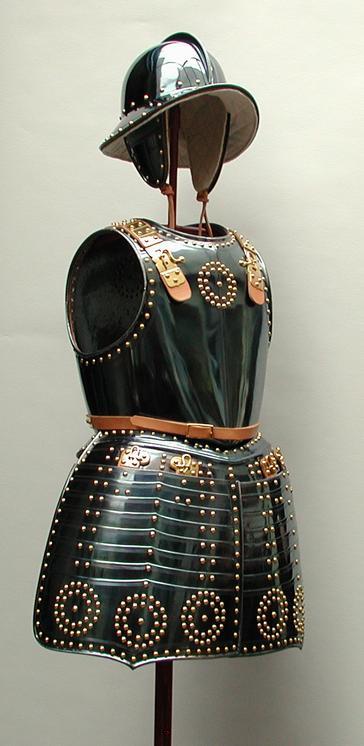 Photo
© Cor van Hooijschuur
Photo
© Cor van HooijschuurComb-cap and pikeman's cuirass
 Photo
© Cor van Hooijschuur
Photo
© Cor van Hooijschuur
Creation after the Dutch model Comb-cap and Pikeman’s cuirass c.1620-150 preserved at the Royal Netherlands Army and Arms Museum Delft, Inv.nr.056251 and Inv.nr. 050231.
Gotscha, 2002. Comb-cap (pikeman’s pot): Infantry helmet of old-fashioned shape for its period. However, it offered good protection against sword blows delivered by attacking cavalry. In 1670, the pikeman in the stadtholder’s guard still wore such helmets. Cuirass: comprising a breastplate and a backplate, held together by leather shoulder straps with iron plates mounted on them and by a narrow leather waistbelt. The breastplate has a nearly straight central ridge terminating underneath in a little cusp; the belly-flange and the neck and arm cut-outs have thick turned rims set off with rows of rivets running parallel to them. Deep belly-flange with two pairs of iron swivel-hooks for attachment of the tassets. In the centre on the breast a large decorative rosette consisting of two concentric circles of rivets. Backplate with flaring loin-flange and decorated with rivets in the same manner. Tassets, one pair, slightly overlapping in the centre at the front, right over left, like a coat, accentuated by a vertical ‘seam’ (rib) with ‘buttons’ (rivets) on the right-hand tasset. Each tasset with nine moulded pseudo-lames with wavy and cusped upper borders, the lover pair of lames wider and each lame decorated with 8… circular decorative rosettes like the breastplate.
Pikemens’s cuirasses like this one were also called corselets. A gorget or an Almain collar was no longer worn with armour and the arms were also unprotected. However, underneath his cuirass the pikeman wore a short buffcoat with sleeves thick enough to give some protection against sword blows. The pikemen in the Dutch army continued to carry these armours in the second half of the 17th century, although the tassets gradually became shorter. The lavishly applied brass rivets gave these cuirasses a rich appearance, underlining the status of their wearers as elite troops among the infantry.
Forged in 1998 in Bergen op Zoom. Material: iron from Hoogovens, surfaces highly polished and blued fire’. The rivets, hinges, eyes and hooks, and the plume holder, gilt. Decorated with engraved lines parallel to all vertical and horizontal edges, all turned edges are finely cabled. Iron plates of different thickness (1.5, 2 and 3 mm) were used to make the 169 separate parts, which form the suit of armour. The sheets of metal were forged cold as well as hot. The suit of armour contains about 450 iron rivets, clasps, hinges, hooks and eyes, each one of them made by hand. Excluding 40 hours of preparation, the work on the suit of armour took 700 hours.